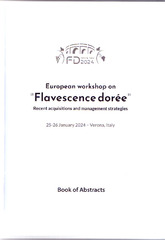Приказ основних података о документу
Insect vectors of "flavescence dorée" and related phytoplasmas in natural areas of riparian habitats in Serbia
| dc.creator | Jović, Jelena | |
| dc.creator | Cvrković, Tatjana | |
| dc.creator | Krstić, Oliver | |
| dc.creator | Mitrović, Milana | |
| dc.creator | Jakovljević, Miljana | |
| dc.creator | Marinković, Slavica | |
| dc.creator | Toševski, Ivo | |
| dc.date.accessioned | 2024-02-01T19:26:52Z | |
| dc.date.available | 2024-02-01T19:26:52Z | |
| dc.date.issued | 2024 | |
| dc.identifier.uri | https://plantarum.izbis.bg.ac.rs/handle/123456789/1215 | |
| dc.description.abstract | “Flavescence dorée” (FD) outbreaks in Serbian vineyards first emerged in the early 2000s and were directly correlated with dense populations of the North American insect vector Scaphoideus titanus. The FD phytoplasma associated with the disease was first treated as alien and introduced, like it happens for its insect vector. However, the genetic peculiarities of FD phytoplasma strains from Serbia, as well as their occurrence in native alder trees in riparian areas and clematis plants in vineyard surroundings and in natural habitats, proved otherwise. Molecular data on the ecological properties of epidemiological cycles driving the epidemic outbreaks of FD in Serbia today indicated the importance of alders as reservoir plants for the epidemics (Krstić et al., 2022). Riparian habitats hosting alder trees, alongside wild Vitis, Salix sp., clematis, tree of heaven, and other FD phytoplasmas reservoir plants, were screened for native leafhopper vectors as well as for Orientus ishidae, a newly established vector of Asian origin in Serbia (Cvrković et al., 2021). Leafhopper Allygus modestus and A. mixtus were commonly found in association with alders in many sites, with the former being the dominant species. An established population of O. ishidae feeding on alders was found in a single location of riparian habitat in eastern Serbia. Among the analyzed leafhopper specimens, using epidemiologically informative map gene typing, nearly all A. modestus individuals were found carrying FD or -related phytoplasmas, while nearly 50% of O. ishidae were found infected at the same location. However, A. modestus specimens had a lower phytoplasma load (Cq > 25) than O. ishidae (Cq < 20 in 50% of infected individuals), even though they were collected in the same period of the year. When comparing the map genotypes carried by each of the putative vector species, A. modestus most often carried AldY genotypes, while O. ishidae was dominantly found harboring FD phytoplasma genotypes of both Map-FD1 and FD2 clusters. The experimental verification of the transmission capability and role in FD phytoplasma epidemiology for each of the leafhopper species is under study. | sr |
| dc.language.iso | en | sr |
| dc.relation | info:eu-repo/grantAgreement/MESTD/inst-2020/200010/RS// | sr |
| dc.relation | Science Fund of the Republic of Serbia, GRANT No. 6808: Endemics and epidemics of grapevine “flavescence dorée” (FD) phytoplasma - tracing and tracking transmission routes – FDemic | sr |
| dc.rights | openAccess | sr |
| dc.rights.uri | https://creativecommons.org/licenses/by/4.0/ | |
| dc.source | European workshop on "Flavescence dorée", Recent acquisitions and management strategies, 25-26 January 2024, Verona, Italy | sr |
| dc.title | Insect vectors of "flavescence dorée" and related phytoplasmas in natural areas of riparian habitats in Serbia | sr |
| dc.type | conferenceObject | sr |
| dc.rights.license | BY | sr |
| dc.citation.epage | 54 | |
| dc.citation.spage | 53 | |
| dc.type.version | publishedVersion | sr |
| dc.identifier.fulltext | http://plantarum.izbis.bg.ac.rs/bitstream/id/3767/bitstream_3767.pdf |


